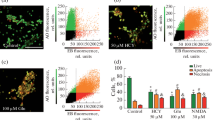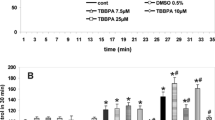Summary
The release of taurine from cultured cerebellar granule neurons was studied in different cell-damaging conditions, including hypoxia, hypoglycemia, ischemia, oxidative stress and in the presence of free radicals. The effects of both ionotropic and metabotropic glutamate receptor agonists on the release were likewise investigated. The release of [3H]taurine from the glutamatergic granule cells was increased by K+ (50mM) and veratridine (0.1 mM), the effect of veratridine being the greater. Hypoxia and ischemia produced an initial increase in release compared to normoxia but resulted in a diminished response to K. Hypoglycemia, oxidative stress and free radicals enhanced taurine release, and subsequent K− treatment exhibited a correspondingly greater stimulation. A common feature of taurine release in all the bove conditions was a slow response to the stimulus evoked by K+ and particularly to that evoked by veratridine. All ionotropic glutamate receptor agonists potentiated taurine release, but only the action of kainate seemed to be receptor-mediated. Metabotropic receptor agonists of group I slightly stimulated the release. The prolonged taurine release seen in both normoxia and cell-damaging conditions may be of importance in maintaining homeostasis in the cerebellum and reducing excitability for a longer period than other neuroprotective mechanisms.
Similar content being viewed by others
Abbreviations
- AIDA:
-
(RS)-1-aminoindan-1,5-dicarboxylate
- AMPA:
-
2-amino-3-hydroxy-5-methyl-4-isoxazolepropionate
- CNOX:
-
6-cyano-7-nitroquinoxaline-2,3-dione
- DCG IV:
-
(2S,2′R,3′R)-2-(2′,3′-dicarboxycyclo-propyl)glycine
- DHPG:
-
(S)-3,5-dihydroxyphenylglycine
- EGLU:
-
(2S)-2-ethylglutamate
- L-AP3:
-
L(+)-2-amino-3-phosphonopropionate
- L-AP4:
-
L(+)-2-amino-4-phosphonobutyrate
- L-SOP:
-
o-phospho-l-serine
- NBOX:
-
6-nitro-7-sulphamoyl[f]quinoxaline-2,3-dione
- NMDA:
-
n-methyl-d-aspartate
- trans-ACPD:
-
(1S,3S)-1-aminocyclopentane-1,3-dicarboxylate
References
Agostinho P, Duarte CB, Carvalho AP, Oliveira CR (1994) Effect of oxidative stress on the release of [3H]GABA in cultured chick retina cells. Brain Res 655: 213–221
Aronica E, Nicoletti F, Condorelli DF, Balázs R (1993) Pharmacological characterization of metabotropic glutamate receptors in cultured cerebellar granule cells. Neurochem Res 18: 605–612
Bernardi N, Assumpcao JA, Dacke CG, Davidson N (1984) Release of labelled taurine from the rat dorsal medulla and cerebellum in vivo. Pflügers Arch Ges Physiol 401: 193–197
Bessho Y, Nawa H, Nakanishi S (1993) Glutamate and quisqualate regulate expression of metabotropic glutamate receptor mRNA in cultured cerebellar granule cells. J Neurochem 60: 253–259
Bessho Y, Nawa H, Nakaniski S (1994) Selective up-regulation of an NMDA receptor subunit mRNA in cultured cerebellar granule cells by K+-induced depolarization and NMDA treatment. Neuron 12: 87–95
Brickley SG, Cull-Candy SG, Farrant M (1996) Development of a tonic form of synaptic inhibition in rat cerebellar granule cells resulting from persistent activation of GABAA receptors. J Physiol (Loud) 497: 753–759
Chan-Palay V, Palay SL, Wu J-Y (1982) Coexistence in human and primate neuromuscular junctions of enzymes synthesizing acetylcholine, catecholamine, taurine andγāminobutyric acid. Proc Natt Acad Sci USA 79: 4221–4225
Chuang D-M, Gao X-M, Paul SM (1992) {spn-Methyl-{spd}-aspartate exposure blocks glutamate toxicity in cultured cerebellar granule cells}. Mol Pharmacol 42: 210–216
Currie DN (1980) Identification of cell types by immunofluorescence in defined cell cultures of cerebellum. In: Giacobini E, Vernadakis A, Shahar A (eds) Tissue culture in neurobiology. Raven Press, New York, pp 75–87
Elster L, Banke T, Kristiansen U, Schousboe A, Wahl P (1998) Functional properties of glycine receptors expressed in primary cultures of mouse cerebellar granule cells. Neuroscience 84: 519–528
Gallo V, Giovannini C, Levi G (1990) Modulation of non-N-methyl-D-aspartate receptors in cultured cerebellar granule cells. J Neurochem 54: 10–16
Holopainen I, Kontro P (1988) Glutamate release from cerebellar granule cells differentiating in culture: modulation of the K+-stimulated release by inhibitory amino acids. Neurochem Int 12: 155–161
Holopainen I, Kontro P, Oja SS (1985) Release of preloaded taurine and hypotaurine from astrocytes in primary culture: stimulation by calcium-free media. Neurochem Res 10: 123–131
Holopainen I, Malminen O, Kontro P (1987) Sodium-dependent high-affinity uptake of taurine in cultured cerebellar granule cells and astrocytes. J Neurosci Res 18: 479–483
Holopainen I, Kontro P, Oja SS (1989) Release of taurine from cultured cerebellar granule cells and astrocytes: co-release with glutamate. Neuroscience 29: 425–432
Holopainen I, Saransaari P, Oja SS (1994) Pharmacological characterization of glutamate binding sites in cultured cerebellar granule cells and cortical astrocytes. Neurochem Res 19: 111–115
Huxtable RJ (1992) The physiological actions of taurine. Physiol Rev 72: 101–163
Kaneda M, Farrant M, Cull-Candy SG (1995) Whole-cell and single-channel currents activated by GABA and glycine in granule cells of the rat cerebellum. J Physiol (Loud) 485: 419–435
Kontro P, Oja SS (1989) Release of taurine and GABA from cerebellar slices from developing and adult mice. Neuroscience 29: 413–423
Kubo T, Takano A, Tokushine N, Miyata N, Sato M, Hatakeyama S (1992) Electrical stimulation-evoked release of endogenous taurine from slices of the hippocampus, cerebral cortex and cerebellum of the rat. J Pharmacobio-Dyn 15: 519–525
Levi G, Patrizio M, Gallo V (1991) Release of endogenous and newly synthesized glutamate and of other amino acids induced by non-N-methyl-D-aspartate receptor activation in cerebellar granule cell cultures. J Neurochem 56: 199–206
Madsen S, Ottersen OP, Storm-Mathisen J (1985) Immunocytochemical visualization of taurine: neuronal localization in the rat cerebellum. Neurosci Lett 60: 255–260
Magnusson KR, Koerner JF, Larson AA, Smullin DH, Skilling SR, Beitz AJ (1991) NMDA-, kainate- and quisqualate-stimulated release of taurine from electrophysiologically monitored rat hippocampal slices. Brain Res 549: 1–8
Morán J, Morales-Mulia S, Hernández-Cruz A, Pasantes-Morales H (1997) Regulatory volume decrease and associated osmolyte fluxes in cerebellar granule neurons are calcium independent. J Neurosci Res 47: 144–154
Namima M, Okamoto K, Sakai Y (1983) Modulatory action of taurine on the release of GABA in cerebellar slices of the guinea pig. J Neurochem 40: 1–9
Nowak L, Ascher P, Berwald-Netter Y (1987) Ionic channels in mouse astrocytes in culture. J Neurosci 7: 101–109
Obrenovitch TP, Urenjak J (1997) Altered glutamatergic transmission in neurological disorders: from high extracellular glutamate to excessive synaptic efficacy. Prog Neurobiol 51: 39–87
Oja SS, Kontro P (1983) Taurine. In: Lajtha A (ed) Handbook of neurochemistry, vol 3, 2nd edn. Plenum Press, New York, pp 501–533
Oja SS, Saransaari P (1996a) Taurine as osmoregulator and neuromodulator in the brain. Metab Brain Dis 11: 153–164
Oja SS, Saransaari P (1996b) Kinetic analysis of taurine influx into cerebral cortical slices from adult and developing mice in different incubation conditions. Neurochem Res 21: 161–166
Owen DB (1962) Handbook of statistical tables. Addison-Wesley, Reading, MA, pp 102–105
Pasantes-Morales H, Schousboe A (1997) Role of taurine in osmoregulation in brain cells: mechanisms and functional implications. Amino Acids 12: 281–292
Pasantes-Morales H, Maar TE, Morän J (1993) Cell volume regulation in cultured cerebellar granule neurons. J Neurosci Res 34: 219–224
Pelmar TC (1995) Use of brain slices in the study of free-radical actions. J Neurosci Meth 59: 93–98
Philibert RA, Rogers KL, Dutton GR (1989) Stimulus-coupled taurine efflux from cerebellar neuronal cultures: on the roles of Ca++ and Na+. J Neurosci Res 22: 167–171
Pocock JM, Nicholls DG (1998) Exocytotic and nonexocytotic modes of glutamate release from cultured cerebellar granule cells during chemical ischaemia. J Neurochem 70: 806–813
Pulsinelli WA (1985) Selective neuronal vulnerability: morphological and molecular characteristics. Prog Brain Res 63: 29–37
Robello M, Amico C, Cupello A (1993) Regulation of GABAA receptor in cerebellar granule cells in culture: differential involvement of kinase activities. Neuroscience 53: 131–138
Santi MR, Ikonomovic S, Wroblewski JT, Grayson DR (1994) Temporal and depolarization-induced changes in the absolute amounts of mRNAs encoding metabotropic glutamate receptors in cerebellar granule neurons in vitro. J Neurochem 63: 1207–1217
Saransaari P, Oja SS (1991) Excitatory amino acids evoke taurine release from cerebral cortex slices from adult and developing mice. Neuroscience 45: 451–459
Saransaari P, Oja SS (1992) Release of GABA and taurine from brain slices. Prog Neurobiol 38: 455–482
Saransaari P, Oja SS (1997a) Neuroprotective actions of taurine. In: Teelken A, Korf J (eds) Neurochemistry: cellular, molecular and clinical aspects. Plenum Press, New York, pp 939–942
Saransaari P, Oja SS (1997b) Enhanced taurine release in cell-damaging conditions in the developing and ageing mouse hippocampus. Neuroscience 79: 847–854
Saransaari P, Oja SS (1997c) Glutamate-agonist-evoked taurine release from the adult and developing mouse hippocampus in cell-damaging conditions. Amino Acids 9: 323–334
Saransaari P, Oja SS (1997d) Taurine release from the developing and ageing hippocampus: stimulation by agonists of ionotropic glutamate receptors. Mech Ageing Dev 88: 142–151
Saransaari P, Oja SS (1998a) Release of endogenous glutamate, aspartate, GABA and taurine from hippocampal slices from adult and developing mice in cell-damaging conditions. Neurochem Res 23: 567–574
Saransaari P, Oja SS (1998b) Mechanisms of ischemia-induced taurine release in mouse hippocampal slices. Brain Res 807: 118–124
Saransaari P, Oja SS (1999a) Taurine release is enhanced in cell-damaging conditions in cultured cerebral cortical astrocytes. Neurochem Res (in press)
Saransaari P, Oja SS (1999b) Involvement of metabotropic glutamate receptors in taurine release in the adult and developing mouse hippocampus. Amino Acids 16: 165–179
Schousboe A, Pasantes-Morales H (1989) Potassium-stimulated release of [3H]taurine from cultured GABAergic and glutamatergic neurons. J Neurochem 53: 1309–1315
Schousboe A, Morán J, Pasantes-Morales H (1990) Potassium-stimulated release of taurine from cultured cerebellar granule neurons is associated with cell swelling. J Neurosci Res 27: 71–77
Schousboe A, Sánchez Olea R, Morán J, Pasantes-Morales H (1991) Hyposmolarity-induced taurine release in cerebellar granule cells is associated with diffusion and not with high-affinity transport. J Neurosci Res 30: 661–665
Szatkowski M, Attwell D (1994) Triggering and execution of neuronal death in brain ischaemia: two phases of glutamate release by different mechanisms. Trends Neurosci 17: 359–365
Taylor CP, Burke SP, Weber ML (1995) Hippocampal slices: glutamate overflow and cellular damage from ischemia are reduced by sodium-channel blockade. J Neurosci Meth 59: 121–128
Virginio C, Cherubini E (1997) Glycine-activated whole cell and single channel currents in rat cerebellar granule cells in culture. Devl Brain Res 98: 30–40
Wahl P, Elster L, Schousboe A (1994) Identification and function of glycine receptors in cultured cerebellar granule cells. J Neurochem 62: 2457–2463
Wills ED (1969) Lipid peroxide formation in microsomes. General conditions. Biochem J 113: 393–396
Zhu WJ, Vicini S (1997) Neurosteroid prolongs GABAA channel deactivation by altering kinetics of desensitized states. J Neurosci 17: 4022–4031
Zhu WJ, Wang JF, Corsi L, Vicini S (1998) Lanthanum-mediated modification of GABAA receptor deactivation, desensitization and inhibitory synaptic currents in rat cerebellar neurons. J Physiol (Lond) 511: 647–661
Author information
Authors and Affiliations
Rights and permissions
About this article
Cite this article
Saransaari, P., Oja, S.S. Enhanced taurine release in cultured cerebellar granule cells in cell-damaging conditions. Amino Acids 17, 323–334 (1999). https://doi.org/10.1007/BF01361658
Received:
Accepted:
Issue Date:
DOI: https://doi.org/10.1007/BF01361658




